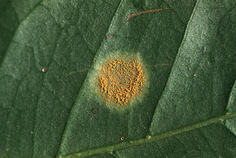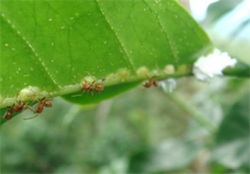|
11/6/2013 0 Comments Our (Pesticide-Laden, Sun-Scorched) Chickens Come Home to Roost As Coffee Roasts No MoreThis week's edition of Leena's Life Sciences Limelight, a column dedicated to research presentations in the life sciences on our campus, focuses on a September 10, 2013 presentation delivered by Dr. John Vandermeer, Asa Gray Distinguished Professor of Ecology and Evolutionary Biology, during an EEB Department Seminar.  Coffee rust, taken from http://www.apsnet.org/. Coffee rust, taken from http://www.apsnet.org/. In his presentation, “Contradictions in Pest Control: A Case Study of Coffee in Mexico” (September 10, 2013), Dr. John Vandermeer discussed a system of convoluted interactions involving predators, parasites, and fungi, which once shielded organic coffee plantations in Mexico and Central America from plant disease and pest outbreaks. Historically, these plantations remained immune to coffee rust, the most harmful disease of coffee plants, which previously devastated coffee production in Sri Lanka. As of last year, however, coffee rust has become a significant issue for these once protected areas.  Taken from www.chicagocustomcoffee.com. Taken from www.chicagocustomcoffee.com. Dr. Vandermeer explained how over the past two decades, a large number of Mexican and Central American coffee growers have forsaken orthodox farming practices, which enabled cultivation of shade-grown coffee, that is, coffee grown under sun-filtering shade trees. In light of recent government pressures to bolster farm production, coffee growers have instead adopted untraditional techniques including regular pesticide treatment and increased use of fertilizers. Concomitant with this heavy chemical treatment includes sun-produced coffee varieties, in which farmers cultivate coffee without the presence of sun-filtering shade trees. Dr. Vandeermeer indicated that the severity of the most recent coffee rust outbreak that has ravaged Mexico and Central America likely has its origins in this transition to sun-produced coffee varieties. This transition, Dr. Vandeermeer believes, prompts the steady collapse of an intricate network of relations found on shaded farms.  Azteca ants, taken from www.thecuttingedgenews.com. Azteca ants, taken from www.thecuttingedgenews.com. In particular, Dr. Vandeermeer proposed that the sudden incidence of the coffee rust outbreak has emerged in light of the gradual degradation of a once intricate coffee agroecosystem, in which a network of species wielded delicate, indirect effects on each other. The Azteca ant, for instance, constitutes an important species in this intricate network of organisms. Given that the Azteca ants nest in the shade trees, the abandonment of traditional agricultural practices involving shade-grown coffee can lead to the diminishment of an important contributor to the agroecosystem; as Azteca ants participate in a mutualistic relationship with the green coffee scale, an insect that preys on the coffee plant, their existence in the agroecosystem confers paramount relevance. Specifically, Dr. Vandeermeer highlighted how the Azteca ants safeguard the scale from predators including the lady beetle; relevantly, only in the presence of extensive populations of scale, which can occur solely when the Azteca ants remain able to safeguard the scale, can the white halo fungus permeate the farm. Through surmounting the scale, from which the Azteca ants derive honeydew through their pair-wise mutualism, the white halo fungus, which naturally also safeguards the coffee plants from coffee rust, incidentally impacts the ants’ subsistence as well. Given that the high pesticide application has undoubtedly resulted in a diminishment of terrestrial biodiversity, however, Dr. Vandeermeer suggested that this particular cultivation mode has triggered the loss of the white halo fungus, and therefore, protection for the coffee plants against coffee rust. A natural defense for the coffee plants, the white halo fungus can no longer effectively curb the viability of the coffee rust, due to its decline resultant from the reduction of biodiversity. Thus, given this complex web of interactions involving various species on the coffee plantations, which has become threatened in light of increased pesticide use and obliteration of shade trees, Dr. Vandeermeer’s research lends important insight into the fragility and subtlety of the agroecosystem dynamic at play on coffee farms in Mexico and Central America. Although recommendations from this study for coffee farmers stand at odds with government pressures and powerful U.S. government agencies, they certainly seek to reinstate a complex ecological balance in light of the present coffee rust outbreak, which, according to Dr. Vandermeer, could become a fairly long-lasting feature of the area. These recommendations include downsizing the expanse of present plantations and abandoning the use of fungicides with the aim that natural restraints might reestablish themselves. About the Blogger  Leena Shah is a sophomore in the College of Literature, Science and the Arts at the University of Michigan concentrating in International Studies with a focus on Global Environment and Health. Her literary interests include religion, slavery, and the politics of knowledge production.
0 Comments
Leave a Reply. |
WELCOME, UMICH SCIENTISTAS!
CAMPUS PICS
WHAT'S NEWUPCOMING EVENTSPAST POSTS
October 2022
SORT BY TAG |
The Scientista Foundation, Inc. All Rights Reserved © 2011-2021 | Based in NY | [email protected]
The Network for Pre-Professional Women in Science and Engineering
The Scientista Foundation is a registered 501(c)(3) -- Donate!
The Network for Pre-Professional Women in Science and Engineering
The Scientista Foundation is a registered 501(c)(3) -- Donate!


 RSS Feed
RSS Feed